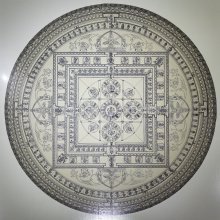Dhanishtha, Dhaniṣṭhā: 18 definitions
Introduction:
Dhanishtha means something in Buddhism, Pali, Hinduism, Sanskrit, Marathi. If you want to know the exact meaning, history, etymology or English translation of this term then check out the descriptions on this page. Add your comment or reference to a book if you want to contribute to this summary article.
The Sanskrit term Dhaniṣṭhā can be transliterated into English as Dhanistha or Dhanishtha, using the IAST transliteration scheme (?).
Images (photo gallery)
In Hinduism
Jyotisha (astronomy and astrology)
Source: Wisdom Library: JyotiṣaDhaniṣṭha (धनिष्ठ):—Name for a particular section of the ecliptic. It is also known as Dhaniṣṭha-nakṣatra. Nakṣatra means “Lunar mansion” and corresponds to a specific region of the sky through which the moon passes each day. Dhaniṣṭha means “most famous” and is associated with the deity known as Vasu (Gods of elements). The presiding Lord of this lunar house is Maṅgala (Mars).
Indian zodiac: |23°20' Makara| – |6°40' Kumbha|
Makara (मकर, “sea-monster”) corresponds with Capricorn and Kumbha (कुम्भ, “pitcher”) corresponds with Aquarius.
Western zodiac: |19°20' Aquarius| – |2°40' Pisces|
Aquarius corresponds with Kumbha (कुम्भ, “pitcher”) and Pisces corresponds with Mīna (मीन, “fish”).
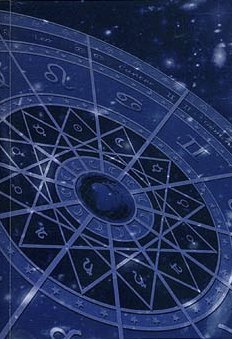
Jyotisha (ज्योतिष, jyotiṣa or jyotish) refers to ‘astronomy’ or “Vedic astrology” and represents the fifth of the six Vedangas (additional sciences to be studied along with the Vedas). Jyotisha concerns itself with the study and prediction of the movements of celestial bodies, in order to calculate the auspicious time for rituals and ceremonies.
Purana and Itihasa (epic history)
Source: Cologne Digital Sanskrit Dictionaries: The Purana IndexDhaniṣṭhā (धनिष्ठा).—The constellation on the Siṃśumāra1 in the Dhruva maṇḍala; good for śrāddha offering;2 inauspicious for house-building.3
- 1) Bhāgavata-purāṇa V. 23. 6; Vāyu-purāṇa 66. 51; 82. 12.
- 2) Brahmāṇḍa-purāṇa II. 24. 134; III. 18. 11; Viṣṇu-purāṇa III. 14. 16.
- 3) Matsya-purāṇa 257. 1.
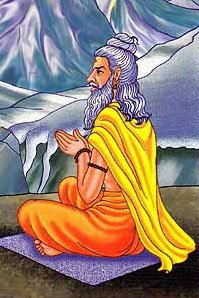
The Purana (पुराण, purāṇas) refers to Sanskrit literature preserving ancient India’s vast cultural history, including historical legends, religious ceremonies, various arts and sciences. The eighteen mahapuranas total over 400,000 shlokas (metrical couplets) and date to at least several centuries BCE.
In Buddhism
Mahayana (major branch of Buddhism)
Source: Wisdom Library: Maha Prajnaparamita SastraDhaniṣṭhā (धनिष्ठा) refers to one of the twenty-seven constellations (nakṣatra) according to according to Mahāprajñāpāramitāśāstra (chapter XIV).—Dhaniṣṭhā is the Sanskrit equivalent of Chinese Wei, Tibetan Mon-gru and modern Delphini.
Dhaniṣṭhā is classified in the second group: “The moon revolves around the earth in 28 days. If the moon enters one of the six following constellations (e.g., Dhaniṣṭhā), then at that moment the earth trembles as if it would collapse and this trembling extends as far as the Nāgas. Then there is no more rain, the rivers dry up, the year is bad for grain, the emperor (T’ien tseu) is cruel and the great ministers are unjust”.
Source: archive.org: Bulletin of the French School of the Far East (volume 5)Dhaniṣṭhā (धनिष्ठा) is the name of a Nakṣatra mentioned in chapter 18 of the Candragarbha: the 55th section of the Mahāsaṃnipāta-sūtra, a large compilation of Sūtras (texts) in Mahāyāna Buddhism partly available in Sanskrit, Tibetan and Chinese.—Chapter 18 deals with geographical astrology and, in conversation with Brahmarāja and others, Buddha explains how he entrusts the Nakṣatras [e.g., Dhaniṣṭhā] with a group of kingdoms for the sake of protection and prosperity.
The Dhaniṣṭhānakṣatra comprises the following realms:
- Nan-t'i-po-mi (Nandivami?),
- Po-lo-che (Paraśi?),
- Man-fou (?),
- Yeou-lo-chö (Uraśa),
- Lan-feou-cha (Lampuṣa),
- Cha-p'o (Sava?),
- Mo-t'o-lo-p'o (Madarava),
- Chai-t'i (?),
- K'ia-cha (Khaṣa),
- P'o-lo-sseu (Varasi?),
- Che-tzeu (Ceylon),
- Ho-po-t'o (Hapada?),
- Ho-li-lieou-che (Harikuji?),
- Yeou-p'o-p'i-lo (Upavīra?),
- To-lo-ni (Taraṇi?),
- P'i-chö-li (Vaiśālī?),
- Yeou-kia-li (Ukari or Utari?).
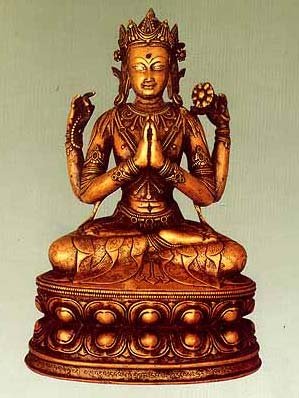
Mahayana (महायान, mahāyāna) is a major branch of Buddhism focusing on the path of a Bodhisattva (spiritual aspirants/ enlightened beings). Extant literature is vast and primarely composed in the Sanskrit language. There are many sūtras of which some of the earliest are the various Prajñāpāramitā sūtras.
Tibetan Buddhism (Vajrayana or tantric Buddhism)
Source: Wisdom Library: Tibetan BuddhismDhaniṣṭhā (धनिष्ठा) refers to one of the various Nakṣatras mentioned as attending the teachings in the 6th century Mañjuśrīmūlakalpa: one of the largest Kriyā Tantras devoted to Mañjuśrī (the Bodhisattva of wisdom) representing an encyclopedia of knowledge primarily concerned with ritualistic elements in Buddhism. The teachings in this text originate from Mañjuśrī and were taught to and by Buddha Śākyamuni in the presence of a large audience (including Dhaniṣṭhā).
Source: archive.org: The Indian Buddhist IconographyDhaniṣṭhā (धनिष्ठा) refers to the twenty-third of the 28 nakṣatras (“constellations”) of the zodiac, as commonly depicted in Buddhist Iconography, and mentioned in the 11th-century Niṣpannayogāvalī of Mahāpaṇḍita Abhayākara.—The nakṣatras are described collectively in the dharmadhātuvāgīśvara-maṇḍala of the Niṣpannayogāvalī. In this maṇḍala the nakṣatras are given one face and two arms, which are clasped against the chest in the añjalimudrā:—“the deities [viz., Dhaniṣṭhā] are decked in bejewelled jackets and they all show the añjali-mudrā”.—In colour, however, they differ. [viz., Dhaniṣṭhā is given the colour blue].
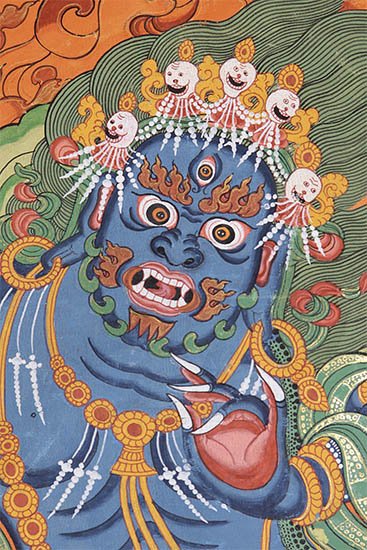
Tibetan Buddhism includes schools such as Nyingma, Kadampa, Kagyu and Gelug. Their primary canon of literature is divided in two broad categories: The Kangyur, which consists of Buddha’s words, and the Tengyur, which includes commentaries from various sources. Esotericism and tantra techniques (vajrayāna) are collected indepently.
Languages of India and abroad
Marathi-English dictionary
Source: DDSA: The Molesworth Marathi and English Dictionarydhaniṣṭhā (धनिष्ठा).—f (S) The twenty-third (or, by another reckoning, the twenty-fourth) nakṣatra.
Source: DDSA: The Aryabhusan school dictionary, Marathi-Englishdhaniṣṭhā (धनिष्ठा).—f The twenty-third nakṣatra.
Marathi is an Indo-European language having over 70 million native speakers people in (predominantly) Maharashtra India. Marathi, like many other Indo-Aryan languages, evolved from early forms of Prakrit, which itself is a subset of Sanskrit, one of the most ancient languages of the world.
Sanskrit dictionary
Source: DDSA: The practical Sanskrit-English dictionaryDhaniṣṭha (धनिष्ठ).—a. Very rich; (Superl. of dhanin or dhanavat).
-ṣṭhā Name of the twenty-third lunar mansion (consisting of four stars).
Source: Cologne Digital Sanskrit Dictionaries: Shabda-Sagara Sanskrit-English DictionaryDhaniṣṭhā (धनिष्ठा).—f.
(-ṣṭhā) The twenty-fourth Nakshatra or lunar mansion, it comprises four stars, and is figured by a drum or tabor. E. dhana to produce, (as corn,) affix ac and matup added, dhanavat again, iṣṭhan added, and matup rejected, fem. affix ṭāp.
Source: Cologne Digital Sanskrit Dictionaries: Benfey Sanskrit-English DictionaryDhaniṣṭhā (धनिष्ठा).—f. The name of a Nakṣatra or lunar mansion, Mahābhārata 13, 4266.
Source: Cologne Digital Sanskrit Dictionaries: Cappeller Sanskrit-English DictionaryDhaniṣṭha (धनिष्ठ).—1. ([superlative]) very quick.
--- OR ---
Dhaniṣṭha (धनिष्ठ).—2. ([superlative]) very rich; [feminine] ā sgl. & [plural] [Epithet] of lunar mansion.
Source: Cologne Digital Sanskrit Dictionaries: Monier-Williams Sanskrit-English Dictionary1) Dhaniṣṭha (धनिष्ठ):—[from dhan] mfn. (superl. of √2. dhan) very swift, [Ṛg-veda x, 73, 1]
2) [v.s. ...] ([from] dhana) very rich, [Śāṅkhāyana-śrauta-sūtra viii, 20, 4]
3) Dhaniṣṭhā (धनिष्ठा):—[from dhaniṣṭha > dhan] f. sg. and [plural] the more modern Name of the Nakṣatra Śraviṣṭhā or 24th lunar mansion, [Śāṅkhāyana-gṛhya-sūtra; Mahābhārata etc.]
Source: Cologne Digital Sanskrit Dictionaries: Yates Sanskrit-English DictionaryDhaniṣṭhā (धनिष्ठा):—(ṣṭhā) 1. f. The 24th lunar mansion, four stars of Delphini.
Source: DDSA: Paia-sadda-mahannavo; a comprehensive Prakrit Hindi dictionary (S)Dhaniṣṭhā (धनिष्ठा) in the Sanskrit language is related to the Prakrit word: Dhaṇiṭṭhā.
[Sanskrit to German]
Sanskrit, also spelled संस्कृतम् (saṃskṛtam), is an ancient language of India commonly seen as the grandmother of the Indo-European language family (even English!). Closely allied with Prakrit and Pali, Sanskrit is more exhaustive in both grammar and terms and has the most extensive collection of literature in the world, greatly surpassing its sister-languages Greek and Latin.
Kannada-English dictionary
Source: Alar: Kannada-English corpusDhaniṣṭha (ಧನಿಷ್ಠ):—
1) [noun] a small northern constellation between Pegasus and Aquila; the Delphinus.
2) [noun] rain received between 2nd and 15th of February.
--- OR ---
Dhaniṣṭha (ಧನಿಷ್ಠ):—[noun] a very rich man.
Kannada is a Dravidian language (as opposed to the Indo-European language family) mainly spoken in the southwestern region of India.
See also (Relevant definitions)
Starts with: Dhanishthanakshatra, Dhanishthapancaka.
Query error!
Full-text (+120): Dhanishthanakshatra, Vasubha, Bhutinidhana, Gagi Guge Dhanishtha, Shravishtha, Vasudevata, Vasava, Pancaka, Vasudevya, Dhanishthe, Dhanavant, Nakshatra, Shravishtha-nakshatra, Gargi, Dhanittha, Panchak, Jaradgava, Dhanavat, Dakshinamarga, Tanittai.
Relevant text
Search found 43 books and stories containing Dhanishtha, Dhaniṣṭhā, Dhanistha, Dhaniṣṭha; (plurals include: Dhanishthas, Dhaniṣṭhās, Dhanisthas, Dhaniṣṭhas). You can also click to the full overview containing English textual excerpts. Below are direct links for the most relevant articles:
Brihat Jataka by Varahamihira [Sanskrit/English] (by Michael D Neely)
Verse 26.16 < [Chapter 27 - The Character of the Drekkana]
Verse 16.12 < [Chapter 17 - Results of the Moon in the Zodiac Signs]
Verse 26.15 < [Chapter 27 - The Character of the Drekkana]
Garuda Purana (by Manmatha Nath Dutt)
Chapter LIX - Discourses on Astrology < [Agastya Samhita]
Chapter LXI - Influences of the moon in her different mansions < [Agastya Samhita]
Chapter LX - Discourses on the period of influences of the different planets with that of the sun < [Agastya Samhita]
Śrī Śrī Rādhikā Aṣṭottara-Śata-Nāma-Stotraṃ (by Śrīla Raghunātha Dāsa Gosvāmi)
Mahabharata (English) (by Kisari Mohan Ganguli)
Section CX < [Anusasanika Parva]
Section LXXXIX < [Anusasanika Parva]
Section LXIV < [Anusasanika Parva]
Sankhayana-grihya-sutra (by Hermann Oldenberg)
International Ayurvedic Medical Journal
Glimpse of astrology in ayurveda < [2016, Issue VIII August]
Music therapy based on individual’s ‘biological humor’ – with reference to medical astrology: a review < [2014, Issue IV Jul-Aug]
